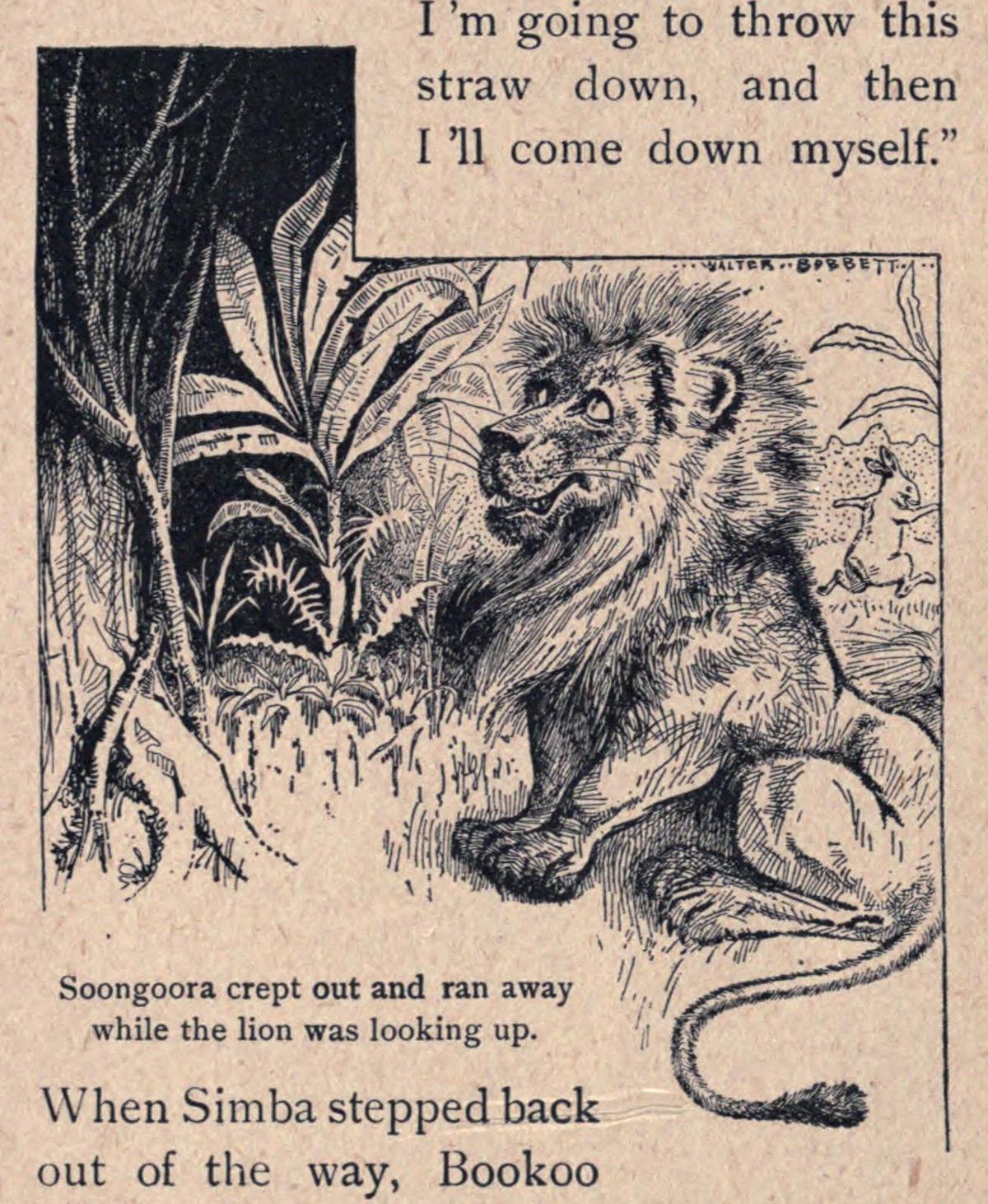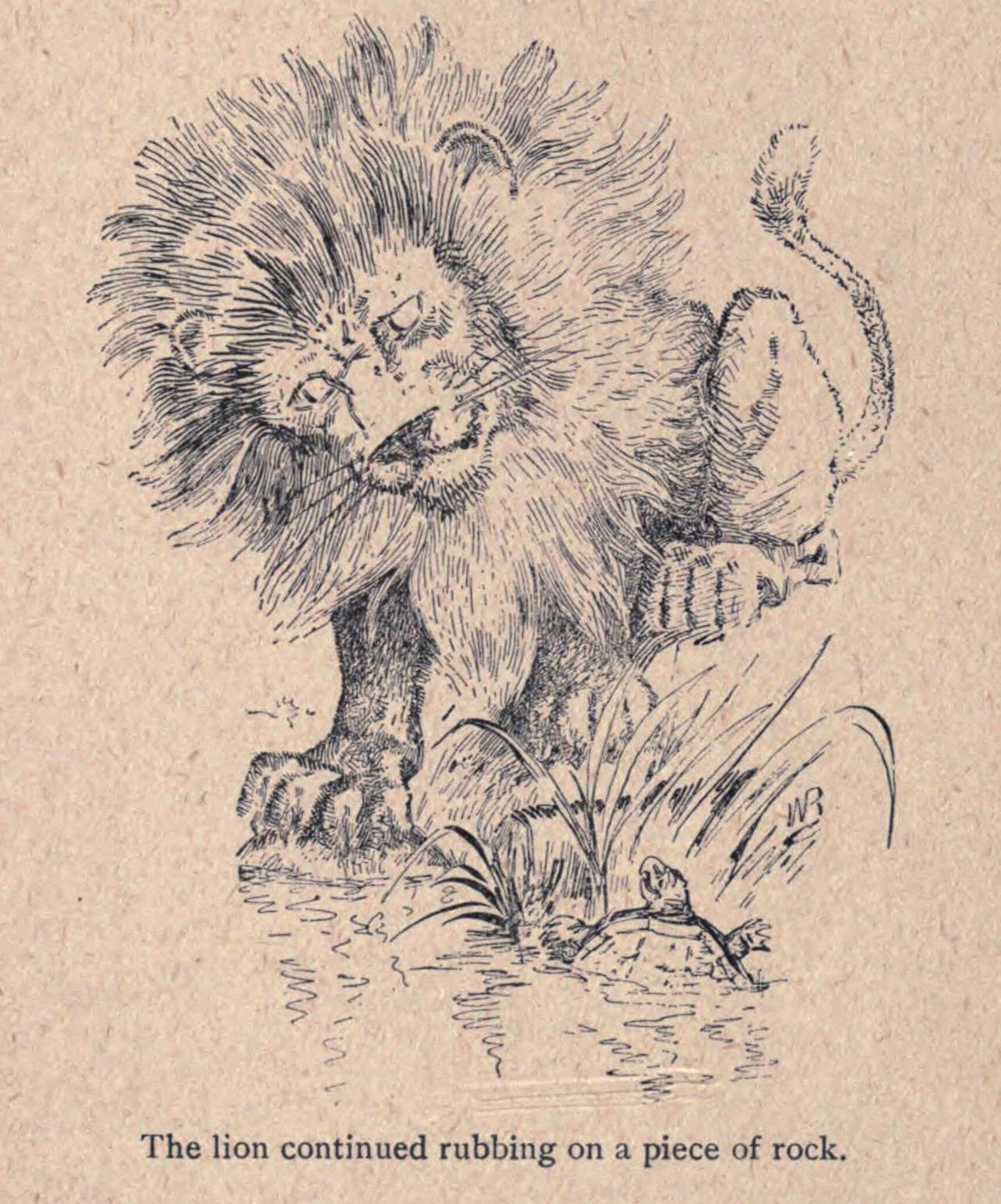[From Zanzibar Tales Told by Natives of the East Coast of Africa by George Bateman, 1901. See item #25 in the Bibliography. The illustrations are by Walter Bobbett.]
One day Soongoora, the hare, roaming through the forest in search of food, glanced up through the boughs of a very large calabash tree and saw that a great hole in the upper part of the trunk was inhabited by bees; thereupon he returned to town in search of someone to go with him and help to get the honey.
As he was passing the house of Bookoo, the big rat, that worthy gentleman invited him in. So the hare went in, sat down, and remarked, “My father has died and has left me a hive of honey. I would like you to come and help me to eat it.”
Of course Bookoo jumped at the offer, and he and the hare started off immediately.
When they arrived at the great calabash tree, Soongoora pointed out the bees’ nest and said, “Go on; climb up.” So, taking some straw with them, they climbed up to the nest, lit the straw, smoked out the bees, put out the fire, and set to work eating the honey.
In the midst of the feast, who should appear at the foot of the tree but Simba, the lion! Looking up and seeing them eating, he asked, “Who are you?”
Then Soongoora whispered to Bookoo, “Hold your tongue; that old fellow is crazy.”
But in a very little while Simba roared out angrily, “I say, who are you? Speak, I tell you!”
This made Bookoo so scared that he blurted out, “It’s only us!”
Upon this the hare said to him, “You just wrap me up in this straw, call to the lion to keep out of the way, and then throw me down. Then you’ll see what will happen.”
So Bookoo the big rat wrapped Soongoora the hare in the straw, and then called to Simba the lion, “Stand back; I’m going to throw this straw down, and then I’ll come down myself.” When Simba stepped back out of the way, Bookoo threw down the straw, and as it lay on the ground, Soongoora crept out and ran away while the lion was looking up.

After waiting a minute or two, Simba roared out, “Well, come down, I say!” and, there being no help for it, the big rat came down.
As soon as he was within reach, the lion caught hold of him and asked, “Who was up there with you?”
“Why,” said Bookoo, “Soongoora the hare! Didn’t you see him when I threw him down?”
“Of course I didn’t see him,” replied the lion in an incredulous tone, and, without wasting further time, he ate the big rat and then searched around for the hare but could not find him.
Three days later, Soongoora called on his acquaintance Kobay, the tortoise, and said to him, “Let us go and eat some honey.”
“Whose honey?” inquired Kobay, cautiously.
“My father’s,” Soongoora replied.
“Oh, alright; I’m with you,” said the tortoise eagerly, and away they went.
When they arrived at the great calabash tree, they climbed up with their straw, smoked out the bees, sat down, and began to eat.
Just then Mr. Simba, who owned the honey, came out again and, looking up, inquired, “Who are you up there?”
Soongoora whispered to Kobay, “Keep quiet,” but when the lion repeated his question angrily, Kobay became suspicious and said, “I will speak. You told me this honey was yours; am I right in suspecting that it belongs to Simba?”
So, when the lion asked again, “Who are you?” Kobay answered, “It’s only us.” The lion said, “Come down then!” and the tortoise answered, “We’re coming.”
Now Simba had been keeping an eye open for Soongoora since the day he caught Bookoo the big rat and, suspecting that Soongoora was up there with Kobay, he said to himself, “I’ve got him this time for sure.”
Seeing that they were caught again, Soongoora said to the tortoise, “Wrap me up in the straw, tell Simba to stand out of the way, and then throw me down. I’ll wait for you below. He can’t hurt you, you know.”
“Alright,” said Kobay but, while he was wrapping the hare up, he said to himself, “This fellow wants to run away and leave me to bear the lion’s anger. He shall get caught first.” Therefore, when Kobay had bundled the hare up, he called out, “Soongoora is coming!” and threw him down.
So Simba caught the hare and, holding him with his paw, he said, “Now what shall I do with you?”
The hare replied, “It’s of no use for you to try to eat me; I’m awfully tough.”
“What would be the best thing to do with you then?” asked Simba.
“I think,” said Soongoora, “you should take me by the tail, whirl me around, and knock me against the ground. Then you may be able to eat me.”
So the lion, being deceived, took the hare by the tail and whirled him around, but just as he was going to knock him on the ground, the hare slipped out of his grasp and ran away, and Simba had the mortification of losing Soongoora again.
Angry and disappointed, he turned to the tree and called to Kobay, “You come down too.”
When the tortoise reached the ground, the lion said, “You’re pretty hard; what can I do to make you eatable?”
“Oh, that’s easy,” laughed Kobay. “Just put me in the mud and rub my back with your paw until my shell comes off.”
Immediately on hearing this, Simba carried Kobay to the water, placed him in the mud, and began to rub his back, or so he thought, but the tortoise had slipped away, and the lion continued rubbing on a piece of rock until his paws were raw. When he glanced down at them, he saw his paws were bleeding and, realizing that he had again been outwitted, he said, “Well, the hare has done me today, but I’ll go hunting now until I find him.”

So Simba the lion set out immediately in search of Soongoora the hare and, as he went along, he inquired of everyone he met, “Where is the house of Soongoora?” But each person he asked answered, “I do not know,” for the hare had said to his wife, “Let us remove from this house.” Therefore the folks in that neighborhood had no knowledge of his whereabouts. Simba, however, went along, continuing his inquiries, until presently one answered, “That is his house on the top of the mountain.”
Without loss of time, the lion climbed the mountain and soon arrived at the place indicated, only to find that there was no one at home. This, however, did not trouble him; on the contrary, saying to himself, “I’ll hide myself inside, and when Soongoora and his wife come home, I’ll eat them both,” he entered the house and lay down, awaiting their arrival.
Pretty soon along came the hare with his wife, not thinking of any danger, but the hare very soon discovered the marks of the lion’s paws on the steep path. Stopping at once, he said to Mrs. Soongoora, “You go back, my dear. Simba the lion has passed this way, and I think he must be looking for me.”
But she replied, “I will not go back; I will follow you, my husband.”
Although greatly pleased at this proof of his wife’s affection, Soongoora said firmly, “No, no! You have friends to go to. Go back.”
So he persuaded her, and she went back, but he kept on, following the footmarks, and saw — as he had suspected — that they went into his house.
“Ah!” said he to himself. “Mr. Lion is inside, is he?” Then, cautiously going back a little way, he called out, “How d’ye do, house? How d’ye do?” Waiting a moment, he remarked loudly, “Well, this is very strange! Every day, as I pass this place, I say, ‘How d’ye do, house?’ and the house always answers, ‘How d’ye do?’ There must be someone inside today.”
When the lion heard this, he called out, “How d’ye do?”
Then Soongoora burst out laughing and shouted, “Oho, Mr. Simba! You’re inside, and I’ll bet you want to eat me, but first tell me where you ever heard of a house talking!”
Upon this, the lion, seeing how he had been fooled, replied angrily, “You wait until I get hold of you; that’s all.”
“Oh, I think you’ll have to do the waiting,” cried the hare, and then he ran away, the lion following.
But it was of no use. Soongoora completely tired out old Simba, who, saying, “That rascal has beaten me; I don’t want to have anything more to do with him,” returned to his home under the great calabash tree.
